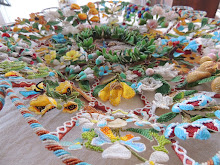 I am so excited about this little toy I just had to share it with you all! Above, you can see my little Diamond in the Rough that I found on eBay. Seller didn't know what it was, I kinda knew what it was....meaning that I could remember seeing something similar, but at that time couldn't remember just where.... Seller had said there was sand leaking from the box, which I found very intriguing so I bought it anyway, it was so utterly charming!
I am so excited about this little toy I just had to share it with you all! Above, you can see my little Diamond in the Rough that I found on eBay. Seller didn't know what it was, I kinda knew what it was....meaning that I could remember seeing something similar, but at that time couldn't remember just where.... Seller had said there was sand leaking from the box, which I found very intriguing so I bought it anyway, it was so utterly charming!

 One thing I could tell for certain, was that the box had never been opened before. Everything was original, except for a single piece of black electrical tape on the back, which was doing absolutely nothing, so it came off first thing! I was very careful to just sit with a flashlight and examine what was inside...there was a funnel shape cone at one end, I could see the wire that dollye was hooked to, a little pin hole at the bottom of the cone~ that's where the sand must pour out from...and nothing else but a neat paddle wheel made out of paper with a metal pin going thru the center.....well~ I am not rocket scientist, but I could tell the little wheel had been bumped and come out of the little socket it was resting in so it wouldn't turn......got my trusty needle nose pliers, placed it carefully back on its axis, and that was it!
One thing I could tell for certain, was that the box had never been opened before. Everything was original, except for a single piece of black electrical tape on the back, which was doing absolutely nothing, so it came off first thing! I was very careful to just sit with a flashlight and examine what was inside...there was a funnel shape cone at one end, I could see the wire that dollye was hooked to, a little pin hole at the bottom of the cone~ that's where the sand must pour out from...and nothing else but a neat paddle wheel made out of paper with a metal pin going thru the center.....well~ I am not rocket scientist, but I could tell the little wheel had been bumped and come out of the little socket it was resting in so it wouldn't turn......got my trusty needle nose pliers, placed it carefully back on its axis, and that was it!
Here you can clearly see the German print on the back of some of the lacquered paper the box was sealed with.
 Once I was sure she was dancing to her little hearts content, I carefully glued the side of the box back in place
Once I was sure she was dancing to her little hearts content, I carefully glued the side of the box back in place Mended her broken arm, and refit the little paper covered glass platform she dances on. This really makes a difference in her movements~ she is much more springy now than in the video~ she really hops and bops! Her feet, each suspended individually on their own little wire, bounce off of it and get her grooving. She is also jointed at the waist by means of wire
Mended her broken arm, and refit the little paper covered glass platform she dances on. This really makes a difference in her movements~ she is much more springy now than in the video~ she really hops and bops! Her feet, each suspended individually on their own little wire, bounce off of it and get her grooving. She is also jointed at the waist by means of wire So I could leave the bottom of this area open, but the originals I have studied have a paper here~ hers would have originally had the green plaid paper continue down to the bottom of the box. It didn't look right to me leaving it empty, so I made my own little secret compartment here~ inside I wrote on a paper the date, and what I did to the box to get her working again, and sealed it inside
So I could leave the bottom of this area open, but the originals I have studied have a paper here~ hers would have originally had the green plaid paper continue down to the bottom of the box. It didn't look right to me leaving it empty, so I made my own little secret compartment here~ inside I wrote on a paper the date, and what I did to the box to get her working again, and sealed it inside I like the looks of it, and it is the ONLY part that I have added to this box~ everything else is original. I just happened to have a partial scrap of an 1849 Grahams book, with a hand marbled endpapers in just her colors~ now how is that for providence! Paper from the same period as when she was made, prolly why it looks so fitting....
I like the looks of it, and it is the ONLY part that I have added to this box~ everything else is original. I just happened to have a partial scrap of an 1849 Grahams book, with a hand marbled endpapers in just her colors~ now how is that for providence! Paper from the same period as when she was made, prolly why it looks so fitting.... As I went carefully around and re-glued all the separating papers, the top revealed a little secret. Under the thick paper, towards the back, was a hole about the size of half a quarter, that was open and directly above the sand funnel~ so obviously these were fully assembled, then filled with sand and the last bit of heavily lacquered paper was glued over the opening to seal it. NEAT!
As I went carefully around and re-glued all the separating papers, the top revealed a little secret. Under the thick paper, towards the back, was a hole about the size of half a quarter, that was open and directly above the sand funnel~ so obviously these were fully assembled, then filled with sand and the last bit of heavily lacquered paper was glued over the opening to seal it. NEAT! Her cover glass horribly dirty.
Her cover glass horribly dirty. But upon close inspection, I could see the remains of the original 'passe partout' embossed gold paper that trimmed the border of the glass front. really neat! All of the original ones I have seen, have a tissue paper border, usually scalloped, at the inside top of the glass, to which mine has just a minuscule amount left~ I decided to leave it as original & charming as it is~ showing its age of nearly 160 years.
But upon close inspection, I could see the remains of the original 'passe partout' embossed gold paper that trimmed the border of the glass front. really neat! All of the original ones I have seen, have a tissue paper border, usually scalloped, at the inside top of the glass, to which mine has just a minuscule amount left~ I decided to leave it as original & charming as it is~ showing its age of nearly 160 years. * above photo copyright Victoria and ALbert Museum, London
* above photo copyright Victoria and ALbert Museum, London
Here is my girl, all ready to perform again. It really is a wonder how she survived all this time~ these are SO very fragile! They weren't kidding at the V& A when they said 'they don't travel well'.... If you ever see one, snatch it up in a heartbeat~ once you hold one, and see and feel and hear it working, you will be mesmerized by its charms just as I have been!



 When I was little, in the early 70s, Ma always made ornaments from real chicken eggs. Coated the inside with
When I was little, in the early 70s, Ma always made ornaments from real chicken eggs. Coated the inside with  Along with this one Ma painted for me in 1976. She made Andy for my brother.
Along with this one Ma painted for me in 1976. She made Andy for my brother.


 One of my little Queen Anne ornaments I made for me this year~ I just love them! She is out of special 18
One of my little Queen Anne ornaments I made for me this year~ I just love them! She is out of special 18

 Do you remember this one Ma??? I cant remember if I got it in Nursery school, or
Do you remember this one Ma??? I cant remember if I got it in Nursery school, or  Some ornaments are too fragile and special for the tree now, so I just unwrap them and look at them for a bit, and put them away safe again. I made this little reindeer in the 3rd grade, from flour dough. He used to have little sticks poked in for his horns.
Some ornaments are too fragile and special for the tree now, so I just unwrap them and look at them for a bit, and put them away safe again. I made this little reindeer in the 3rd grade, from flour dough. He used to have little sticks poked in for his horns.  And last, this one~ a little Holly
And last, this one~ a little Holly 
 Pictured above, the Dolomites~ part of the Alps in Northern Italy and SO breathtaking! This is the birthplace of my dollys, and so many others. The Grodner Thal, or Grodner Valley, is home to several wonderful little villages, but the center of doll making was St. Ulrich (Ortesei as known by locals). A very pioneering woman, Amelia B Edwards, came upon St. Ulrich while hiking int he Dolomite Range in the early 1870's and told all about her experience in a book she wrote in 1873, 'Untrodden Peaks and Unfrequented Valleys'. She toured the warehouses while there and reported
Pictured above, the Dolomites~ part of the Alps in Northern Italy and SO breathtaking! This is the birthplace of my dollys, and so many others. The Grodner Thal, or Grodner Valley, is home to several wonderful little villages, but the center of doll making was St. Ulrich (Ortesei as known by locals). A very pioneering woman, Amelia B Edwards, came upon St. Ulrich while hiking int he Dolomite Range in the early 1870's and told all about her experience in a book she wrote in 1873, 'Untrodden Peaks and Unfrequented Valleys'. She toured the warehouses while there and reported
 As you can see, if you click on and enlarge the photo, that our jacket skirting is about midway between full-on skirting, and half skirting, ending at the hip sides. The top fullness
As you can see, if you click on and enlarge the photo, that our jacket skirting is about midway between full-on skirting, and half skirting, ending at the hip sides. The top fullness 




 The sleeves are expertly pleated then held with a chain stitch only. The pointed sleeve cap is a very
The sleeves are expertly pleated then held with a chain stitch only. The pointed sleeve cap is a very  The same chain stitch holds the
The same chain stitch holds the 





















